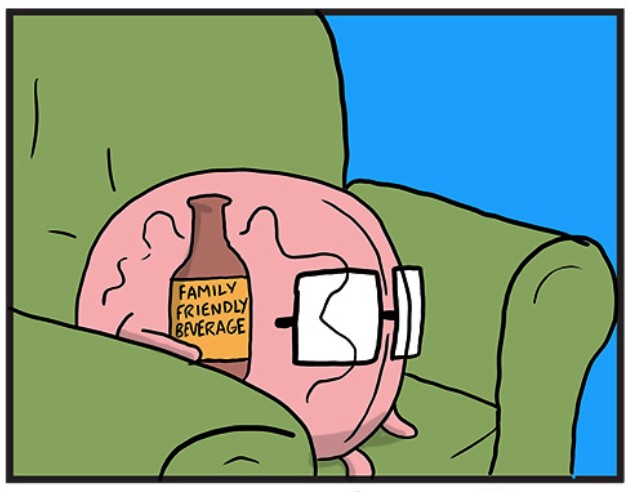Sanatorium for the brain: how not to force the user to strain

© The Awkward Yeti
They say laziness is the engine of progress. It is not true. Laziness does not move anything, because she is lazy.
In fact, the engine of progress is the desire for comfort and that in order to achieve a result you have to perform as little as possible. And then you can either be lazy, or waste your time on great things for which we were all born.
Thinking about comfort, we imagine a soft bed, warm weather, pleasant sounds and other tangible bodily joys. However, we must not forget that our brain also needs such pleasures (it is worth noting that this thought was suggested to me by the brain, so perhaps it is just cunning).
This wonderful organ itself strives not to do routine tasks, so we brush our teeth, insert keys into locks and get up from the chair without really thinking about these actions. And it is important to remember that one of the main tasks of designers and productologists is precisely to provide the user's brain with such comfort, or, to put it poeticly, to reduce cognitive load.
')
Let's figure out how to achieve this.
Less questions
Every question that we explicitly or implicitly ask the user is an obstacle. And the more such obstacles we create on the way to getting value from our product, the stronger the user must be motivated in achieving the result.
No one is embarrassed by filling out personal information and two-factor authorization in financial products, which allow you to make a profit or not incur losses.
Users are happy to upload photos and paint their dignity for a long time in the dating services in the hope of finding love of life or at least one night.
You also need to fill in many different fields on the airline's website or, what the hell is not joking, RZD to get to one or another point of the world, but it's worth it.
At the same time, the user who came to your application for funny pictures and videos with cats, is hardly ready to spend five minutes on the first questionnaire “What kind of jokes do you like?” When you first start. And two minutes is not ready. In general, if he does not like the first screen, he can simply leave. To avoid this, marketing enters the battle, which convinces the user in advance that all this is vital for him. But that's another story.
Thus, each opportunity to avoid unnecessary questions gradually creates a feeling of comfort: as you use good products, the fields begin to fill automatically, frequent tasks are solved in one click, and life becomes more pleasant, because there is almost no room for routine in it.
Closed questions
You are writing to an old friend: “Hi! Long time no see". This is a shifting of responsibility. That is, you did not ask the question at all and, apparently, suggest to guess that you want to meet.
"Hello! Long time no see. How about drinking tea tonight? ”This option is already better, because there is a question and information for consideration.
"Hello! Long time no see. Let's have some tea today at seven in a cafe on the corner. Free? ”But this moment is critical, because our interlocutor moves from thinking “ when can I meet with him? ” To the simple question “ Will I be able to come to the corner cafe at seven today? ”
Yes, perhaps, the time is inconvenient, and then you have to figure out other options, but in the case of a positive outcome, we shortened the way as far as possible before making a decision. And in the case of a negative one, the interlocutor was encouraged by the fact that he quickly coped with a simple task and moved on to a more complex, related to the previous one.
In applications, the story is the same, only in most cases our friend will be completely lazy and will not prompt when he is free. Therefore, we do not ask you to enter gender into letters in information about yourself, but use switches. Yes, I know that not only for this reason, but in general, interface elements with a choice of options reduce the number of ways in which the brain can go towards thinking and distract or get tired.
Or, therefore, Facebook immediately after registration does not offer you to search for relatives and friends on your own, but shows their photos and names and asks “Do you know them?”, Then it remains to press one button.
By the way, the invitation example in the cafe mentioned above is a typical call-to-action, another way to encourage the user to make a decision. Therefore, we write "try", "call", "write", "write, so we called and you tried." Links that say “well, you can click, but you can not click,” do not motivate, and the incentive or infinitive clearly indicate what awaits us further. It remains for us to decide whether we want it or not, and the “try” format also pushes this.
However, this is again marketing and a slightly different format of influence on the brain. We will not be distracted.

© Owlturd comix
Feeling of control
You are in a restaurant together. Or even better for this example - five of us. Everything is all ordered, continue to communicate. At some point, the waiter brings four hot to your friends and leaves.
He will return? He could not carry five plates? Is your dish preparing longer, or has it not mistakenly entered an order into the system? Or just did not hear how you ordered it?
A good waiter will surely say: “Your hot will be ready in 2 minutes” and, perhaps, something else that is necessary in this particular establishment.
A good product will also behave, because it is more important to reduce the number of questions to the user only by creating conditions in which the user will not need to ask questions himself - especially if you consider that the application, like the runner’s waiter, will not answer.
On the way to the ability of the user to control the situation, a lot of things happened: tooltips and detailed error messages; confirmation or quick cancellation of dangerous actions; design guidelines for predicting the purpose of most buttons; color coding and animation of transitions between screens; after all, metaphors from the real world to overcome the fear of the unknown.
Yes, if everything is arranged in its own way, the user will click once and, perhaps, will remember. But every slight feeling of discomfort when using your product is a minus to the trust you have been given, which may end sooner or later.
And most importantly - the user must really want to remember it. And if your application does not control the apparatus of artificial respiration or something of comparable importance, this may not be the case. I'm not saying that you can make ugly controls on expensive medical equipment: just if the user's life depends on it, he will hate you, but he will adjust. In the case of less important things, he simply removes the application and goes to look for another.
Pleasant trifles
In my hometown, some traffic lights begin to flash when there is three seconds left on the timer, and switch to yellow, reaching zero, while others first reach zero, and only then another three seconds flash without a timer.
It would seem that this is nonsense, but every time there is a few seconds left before the switch, I have to think whether I have time or not. Not to think in the spirit of “what would I do if I were appointed to govern a country in which no one speaks my language?”, But not much, not serious - the level of discomfort is almost as if you were pushing from the floor, and at this time your back was combing.
It seems to be a trifle, but unpleasant. For those who do not believe that this may be important, another story about the same characters: a long time ago in one small and not very proud town, several traffic lights were updated, which differed in the duration of the flashing green signal from all other traffic lights in the city. Both those and others fit into the 2-4 seconds required by GOST, only 4 were for all, and 2 for the new ones.
So, the number of accidents at intersections with these traffic lights has increased dramatically, and when an error was discovered and corrected, everything returned to previous indicators.
The end.
What I'm trying to say: a cool product is different from just a good love of detail. And if at the initial stage you need to solve the most frequent problems with minimal efforts, then a mature product is simply obliged to overgrow with pleasant buns that make life easier for not all users: but those who will ease it will love their product with all their hearts and don’t even want to consider other options.
So do not forget about the details. In them the devil.

© Adventures of God
Love brains
Users are, of course, lazy, mischievous villains. They don’t want to understand our beautiful ideas, they don’t go to the settings, and even the bad reviews are written instead of getting deep ideas.
However, as in any relationship, someone must take the first step. And it is important to remember that this is in our interests: it’s not just romance, but also the achievement of business goals.
For example, to increase the conversion of users to registered users, you can reduce the number of questions that prevent this: remove unnecessary fields from the registration form and specify details later.
And to increase the time of the session on the main page of YouTube (and everyone else), ask not the question “What video do you want to watch?”, But the questions “Do you want to spend 2 minutes and 42 seconds to watch this video?”. After that, it will only be necessary to collect information to improve the recommendations of the algorithms and increase the number of positive answers.
Or you can slip into a Instagram Instagram of people you don’t know with the offer to subscribe to them. You would never get to this action, if the developers just gave you a search field, and then a direct question with a picture: “Look, what a curious little bit freaky - do you want to subscribe?”
It always works: recently my wife told me to buy cheese for Greek salad at the store. I saw the packaging on the display, and on it was painted a salad and a large cube of cheese.
I thought: "It seems that this is needed," and on the packaging it says "Ideal for a salad."
Here are just packaging like melted cheese, and I thought: “But you need cubes, not melted cheese,” and on the package it says “Keeps shape”.
That is, the cheese packaging has worked with my objections, do you understand? Not all sales managers can do this.
So build long-term and mutually beneficial relationships with your users and solve your problems through their convenience .
Then the users and the board of directors will be happy.
Source: https://habr.com/ru/post/349466/
All Articles